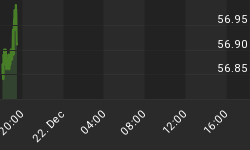The good news is:
• Many of the major averages closed at a multi year high Friday.
The Dow Jones Industrial Average and all of the broad based S&P indices closed at multi year highs while the S&P mid and small cap indices closed at all time highs Friday. That combination for many defines a bull market.
Speculative issues including small caps do well in the early stages of a bull market. As the bull market ages, speculators and investors become more risk averse and shift to the larger capitalization issues. That shift appears to be underway now.
The first chart covers the run up from the August lows through last Friday.
The Russell 2000 (R2K) is shown in red, the S&P 500 (SPX) in green and a FastTrack relative strength indicator called Accutrack as a histogram in yellow. In the early stages of this run up Accutrack rose sharply and remained well above the neutral or 0 line. Accutrack fell below the 0 line shortly after the 1st of this year and has been modestly positive at best for two periods this year. The R2K has lost its leadership role.

The SPX made its new high on Friday with the help of fewer issues than it had at its previous high in late December.
The chart below shows the SPX in red and the percentage of its component issues that are above their 50 day Exponential Moving Averages (EMA's) in green. At the high in late December 85% - 90% of the component issues of the SPX were above their 50 day EMA's. At the new high on Friday only 68% of the component issues of the SPX were above their 50 day EMA's.

The SPX made its new high Friday with fewer of its component issues making new highs.
The chart below shows the SPX in red and a 20% trend (4 day EMA) of new lows subtracted from new highs. For this chart, new highs and new lows have been calculated over the past 6 weeks rather than the past 52 weeks as reported by the exchanges.
New highs - new lows of the component issues of the SPX peaked in November and have been progressively declining with every new high in the index.

The SPX is a capitalization weighted index so its larger capitalization components have a greater influence on the index than its smaller cap components. The shift to less speculative (read large cap) issues is underway by nearly every measure.
As speculative issues go, the fiber optics segment of the telecom sector is a good example. In the late 90's companies such as JDS Uniphase, Ciena, Finisar and Corning were white hot, accumulating capitalizations that moved the major indices. There is not much left of them now, but they remain targets of speculators.
The chart below shows the recent performance of an index of 12 fiber optic issues. After rising 40% from the August low to a late December high, the index has fallen 26% and is almost back to its August low. More evidence of a declining appetite for risk.

Seasonally, March has little to offer.
Since 1963 the NASDAQ composite (OTC) has been up 60% of the time averaging a 0.2% gain over all years. Looking at March in the 1st year of the presidential cycle the OTC has been up only 40% of the time and averaging a loss of 1.7%, but the loss % is skewed by a huge 15.7% loss in 2001.
Since 1928 the SPX has also been up 60% of the time also averaging a 0.2% gain over all years. Isolating the 1st year of the presidential cycle the index has been up 53% of the time averaging a loss of 0.3%.
The charts below show a daily average for March for the OTC and SPX. The number of trading days varies a little, but is usually 21. The chart is created by using the first 11 days of the month and the last 10. In a few years extra days are inserted near the middle and in some years days are deleted near the middle.
The first chart shows the OTC. March of all years since 1963 are averaged and shown in the blue line. March of the 1st year of the presidential cycle since 1963 are shown in the green line.

The next chart shows the SPX. March of all years since 1928 are averaged and shown in the black line. March of the 1st year of the presidential cycle since 1928 are shown in the green line.
Seasonally the high in March usually occurs between the 4th and 6th trading day (last Friday to next Tuesday).
The rally that gave us new highs Friday may have a few days left and it is possible the dip or consolidation that follows will be followed by another blue chip high, but risk is high and increasing.
I expect the major indices to be lower on Friday March 11 than they were on Friday March 4.
Gordon Harms produces a power point for our monthly FastTrack users group meeting. You can download the most recent one at: http://www.guaranteed-profits.com















